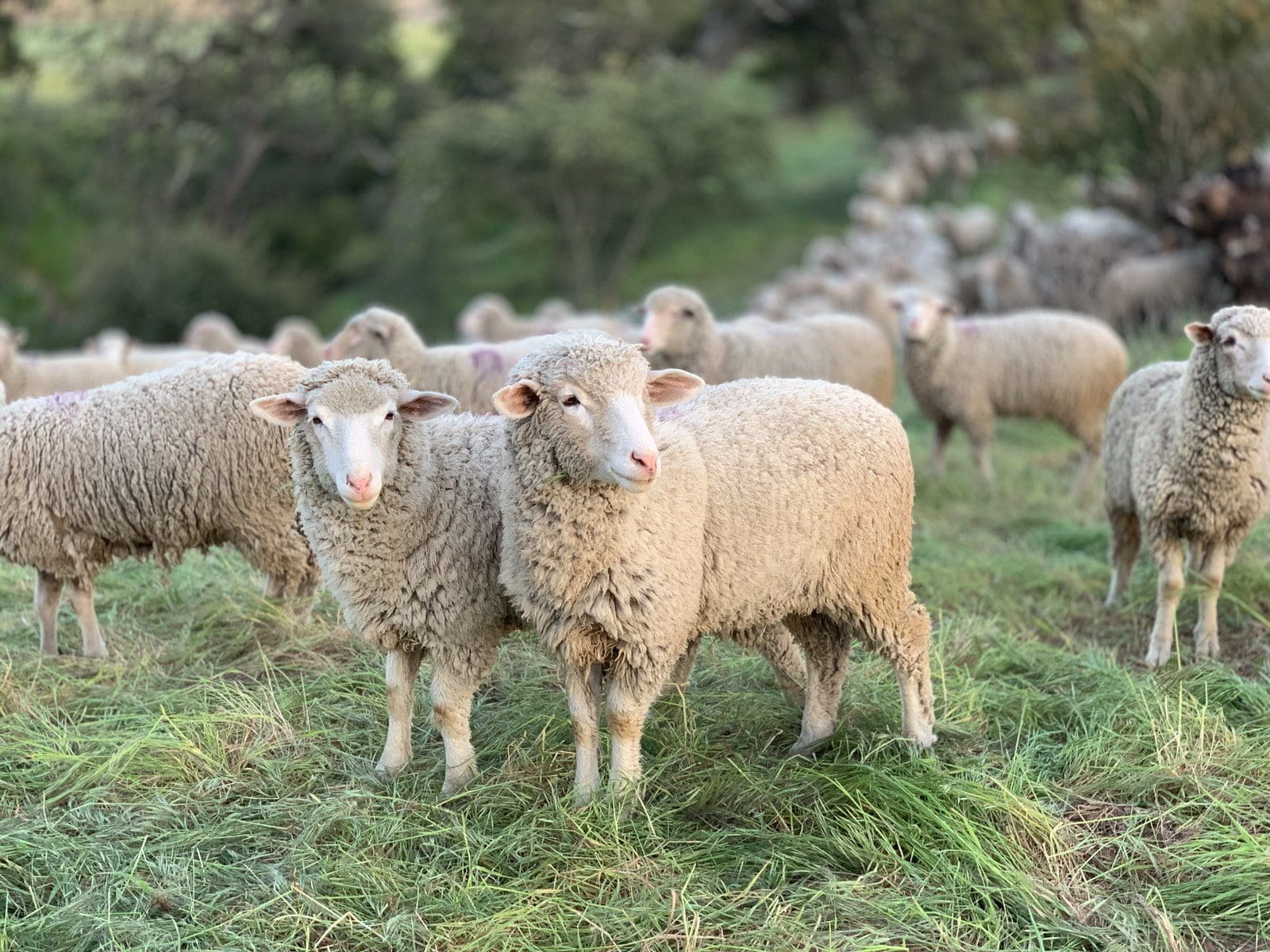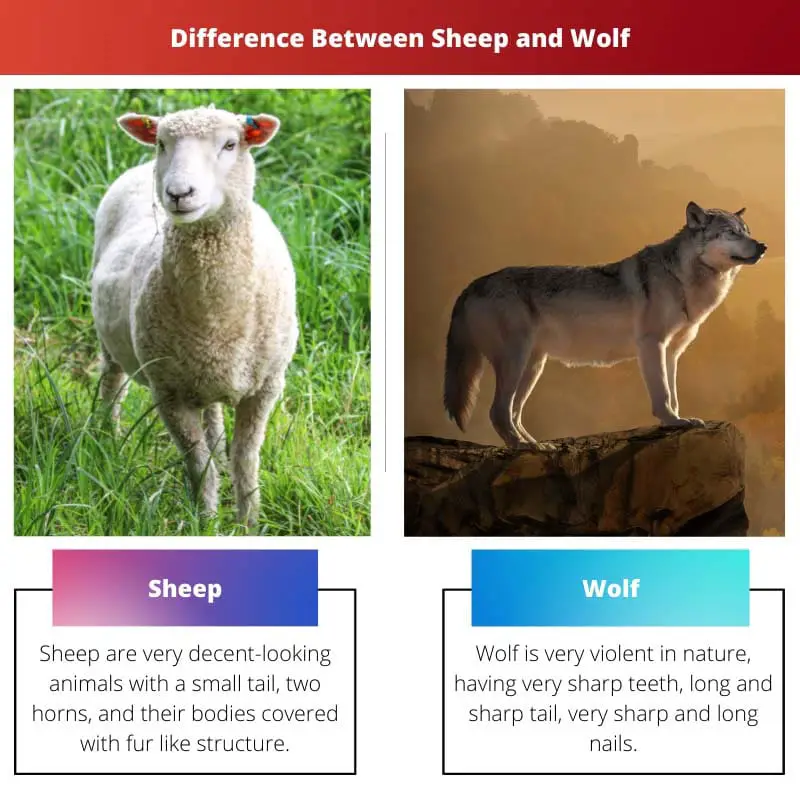There are so many animals. Some animals can be kept as pets, but some cannot because of the danger or damage they can do to a person. Sheep and Wolfs are the two animals that can be easily differentiated by the level of risk they can cause.
Sheep are herbivores, and young sheep are called lambs. Their fur is used for making wool. While wolves are carnivores, wolves have less market value than sheep.
Sheep are primarily found in hills or mountain regions and are well adapted to extreme climates like the middle east, Asia, etc. While Wolf is found in cold areas, they are well adapted to desert regions, grasslands, etc.
Key Takeaways
- Sheep and wolves are two distinct animals with contrasting characteristics and behaviors.
- Sheep are docile herbivores raised for wool and meat, while wolves are carnivorous predators that hunt in packs.
- Sheep are social animals that form herds and follow a leader, while wolves are highly territorial and have a complex social hierarchy.
Sheep vs Wolf
Sheep are herbivores and can be kept as a pet, whereas wolves are carnivores, meaning they only eat non-vegetarian foods and cannot be marked as a pet. Sheep are a good source of money. They are kept as a pet or domesticated for farming purposes.

Sheep are counted as valuable animals primarily because of their meat and milk. Sheep come from the Bovidae family, whose scientific name is Ovis aries. They are non-violent animals and come under the kingdom of Mammalia because they produce milk.
Wolf is the most violent animal. They came from the family of Canidae, the same as the dog family.
They are not very resourceful as sheep are. They are mainly used as antiques and slightly used as animal fibre.
Comparison Table
| Parameters of Comparison | Sheep | Wolf |
|---|---|---|
| Body Characteristics | Sheep are very decent-looking animals with a small tails, two horns, and bodies covered with fur-like structures. | Wolf is very violent, having very sharp teeth, long and sharp tails, and very sharp and long nails. |
| Family | Sheep belong to the Bovidae family. | Wolf belongs to the Canidae family. |
| Presence of horns | Some sheep have horns. | Wolf does not have horns. |
| Domestication possibility | They have been kept as pets for centuries. | They cannot be domesticated because of their high level of danger and violent nature. |
| Tail size | Tails are small in size. | Tails are long and pointed. |
| Prefered food | Sheep are herbivores. They eat green grasses. | Wolf are carnivores, and they eat meat or other animals. |
| Weight | Sheep are much heavier than wolves as sheep weigh around 45-160kg for males and 45-100kg for females. | Wolf is less heavy compared to sheep. Wolf have they weigh around 40kg for males and 37kg for females. |
| Scientific nomenclature. | Sheep are scientifically named Ovis aries. | Wolf is called Canis lupus scientifically. |
What is Sheep?
Sheep are very useful for animal husbandry purposes, and they are herbivores. They are also preferred for their meat and milk.
They have four legs and a short tail, and their body is covered with thick cotton-like hairs, which are used as wool after shearing. Sheep production is mainly associated with European countries.
Sheep fall under the Bovidae family in the animal kingdom, and their scientific name is Ovis aries. They look similar to goats, but they have a fur-like appearance in their body which is thick and slightly more prominent.
Sheep are primarily used in traditional systems as an animal sacrificed for God. Sheep were among the earliest animal to be kept as a pet like dogs. Their lifespan is around 10-12 years.

What is Wolf?
Wolf belongs to the Canidae family and is scientifically named Canis lupus. Wolf is very violent, having very sharp teeth, long and sharp tails, and very sharp and long nails. They are the most dangerous hunter and have unique prey-hunting techniques.
Females weigh around 37kg, and males weigh about 40kg. They do not have much market value because they have fewer resources. Their snout is much broader than jackals and coyotes.
Their body is covered with thick fur because of their habitat. Wolf are carnivores which means they eat other herbivore animals as their food, for example, deer, sheep, moose, etc.

Main Differences Between Sheep and Wolf
- Sheep fall under the Bovidae family in the animal kingdom, and their scientific name is Ovis arise. At the same time, Wolf belongs to the Canidae family and is scientifically named Canis lupus.
- A sheep’s lifespan is approximately 10-12 years, and Wolf’s is about 10-16 years.
- Sheep are herbivores. They eat green grasses. And wolfs are carnivores which means they eat other herbivore animals as their food. For example, deer, sheep, moose, etc.
- Wolf is a dangerous animal having sharp teeth, long nails, and excellent hunting skills. While sheep are decent animals with non-violent natures with thick fur-like structures and horns, their bodies are covered with thick fur-like structures.
- Sheep weigh around 45-100kg, while a wolf weighs only approximately 40 kg, significantly less than sheep.




